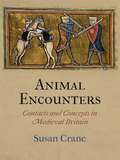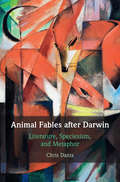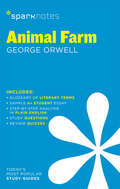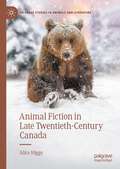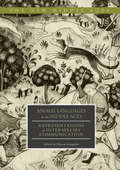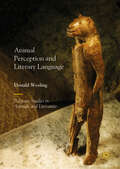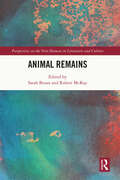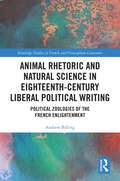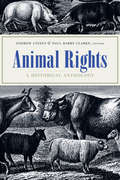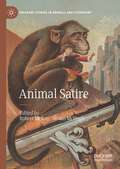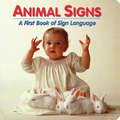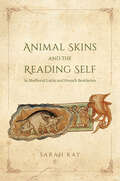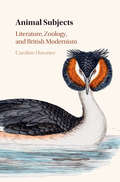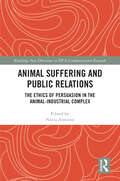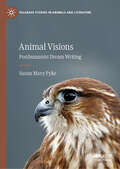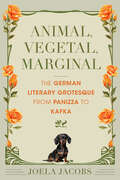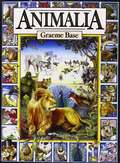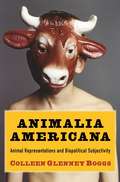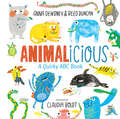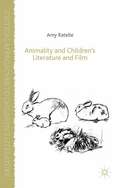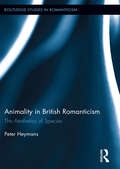- Table View
- List View
Animal Encounters
by Susan CraneTraces of the living animal run across the entire corpus of medieval writing and reveal how pervasively animals mattered in medieval thought and practice. In fascinating scenes of cross-species encounters, a raven offers St. Cuthbert a lump of lard that waterproofs his visitors' boots for a whole year, a scholar finds inspiration for his studies in his cat's perfect focus on killing mice, and a dispossessed knight wins back his heritage only to give it up again in order to save the life of his warhorse. Readers have often taken such encounters to be merely figurative or fanciful, but Susan Crane discovers that these scenes of interaction are firmly grounded in the intimate cohabitation with animals that characterized every medieval milieu from palace to village. The animal encounters of medieval literature reveal their full meaning only when we recover the living animal's place within the written animal.The grip of a certain humanism was strong in medieval Britain, as it is today: the humanism that conceives animals in diametrical opposition to humankind. Yet medieval writing was far from univocal in this regard. Latin and vernacular works abound in other ways of thinking about animals that invite the saint, the scholar, and the knight to explore how bodies and minds interpenetrate across species lines. Crane brings these other ways of thinking to light in her readings of the beast fable, the hunting treatise, the saint's life, the bestiary, and other genres. Her substantial contribution to the field of animal studies investigates how animals and people interact in culture making, how conceiving the animal is integral to conceiving the human, and how cross-species encounters transform both their animal and their human participants.
Animal Fables after Darwin: Literature, Speciesism, and Metaphor
by Chris DantaThe ancient form of the animal fable, in which the characteristics of humans and animals are playfully and educationally intertwined, took on a wholly new meaning after Darwin's theory of evolution changed forever the relationship between humans and animals. In this original study, Chris Danta provides an important and original account of how the fable was adopted and re-adapted by nineteenth- and twentieth-century authors to challenge traditional views of species hierarchy. The rise of the biological sciences in the second half of the nineteenth century provided literary writers such as Robert Louis Stevenson, H. G. Wells, Franz Kafka, Angela Carter and J. M. Coetzee with new material for the fable. By interrogating the form of the fable, and through it the idea of human exceptionalism, writers asked new questions about the place of the human in relation to its biological milieu.
Animal Farm (MAXNotes Literature Guides)
by Joseph ScaliaREA's MAXnotes for George Orwell's Animal Farm MAXnotes offer a fresh look at masterpieces of literature, presented in a lively and interesting fashion. Written by literary experts who currently teach the subject, MAXnotes will enhance your understanding and enjoyment of the work. MAXnotes are designed to stimulate independent thought about the literary work by raising various issues and thought-provoking ideas and questions. MAXnotes cover the essentials of what one should know about each work, including an overall summary, character lists, an explanation and discussion of the plot, the work's historical context, illustrations to convey the mood of the work, and a biography of the author. Each chapter is individually summarized and analyzed, and has study questions and answers.
Animal Farm SparkNotes Literature Guide (SparkNotes Literature Guide Series #16)
by SparkNotesAnimal Farm SparkNotes Literature Guide by George Orwell Making the reading experience fun! When a paper is due, and dreaded exams loom, here's the lit-crit help students need to succeed! SparkNotes Literature Guides make studying smarter, better, and faster. They provide chapter-by-chapter analysis; explanations of key themes, motifs, and symbols; a review quiz; and essay topics. Lively and accessible, SparkNotes is perfect for late-night studying and paper writing. Includes:An A+ Essay—an actual literary essay written about the Spark-ed book—to show students how a paper should be written.16 pages devoted to writing a literary essay including: a glossary of literary termsStep-by-step tutoring on how to write a literary essayA feature on how not to plagiarize
Animal Fiction in Late Twentieth-Century Canada (Palgrave Studies in Animals and Literature)
by Alice HiggsAnimal Fiction in Late Twentieth-Century Canada fulfils a vital contribution to the conversation surrounding animal representation as a point of continuity in national narratives and supports the idea that focusing on narratives of responsibility and care influences better relations with both non-human animals and across settler-Indigenous boundaries. Alice Higgs engages with on-going debates regarding reconciliation by demonstrating that it is imperative to critique settler colonial environmental frameworks and place autonomy back into Indigenous communities by bringing Indigenous practices of custodianship and relationality to bear more generally. This book also develops a number of conversations in animal studies in relation to the politics of representation. Higgs studies a range of canonical Canadian authors, demonstrating a progress across the period in which it is possible to identify the emergence of a literary pro-animal turn.
Animal Languages in the Middle Ages: Representations of Interspecies Communication (The New Middle Ages)
by Alison LangdonThe essays in this interdisciplinary volume explore language, broadly construed, as part of the continued interrogation of the boundaries of human and nonhuman animals in the Middle Ages. Uniting a diverse set of emerging and established scholars, Animal Languages questions the assumed medieval distinction between humans and other animals. The chapters point to the wealth of non-human communicative and discursive forms through which animals function both as vehicles for human meaning and as agents of their own, demonstrating the significance of human and non-human interaction in medieval texts, particularly for engaging with the Other. The book ultimately considers the ramifications of deconstructing the medieval anthropocentric view of language for the broader question of human singularity.
Animal Perception and Literary Language (Palgrave Studies in Animals and Literature)
by Donald WeslingAnimal Perception and Literary Language shows that the perceptual content of reading and writing derives from our embodied minds. Donald Wesling considers how humans, evolved from animals, have learned to code perception of movement into sentences and scenes. The book first specifies terms and questions in animal philosophy and surveys recent work on perception, then describes attributes of multispecies thinking and defines a tradition of writers in this lineage. Finally, the text concludes with literature coming into full focus in twelve case studies of varied readings. Overall, Wesling's book offers not a new method of literary criticism, but a reveal of what we all do with perceptual content when we read.
Animal Remains (Perspectives on the Non-Human in Literature and Culture)
by Robert McKay Sarah BezanThe dream of humanism is to cleanly discard of humanity’s animal remains along with its ecological embeddings, evolutionary heritages and futures, ontogenies and phylogenies, sexualities and sensualities, vulnerabilities and mortalities. But, as the contributors to this volume demonstrate, animal remains are everywhere and so animals remain everywhere. Animal remains are food, medicine, and clothing; extractive resources and traces of animals’ lifeworlds and ecologies; they are sites of political conflict and ontological fear, fetishized visual signs and objects of trade, veneration and memory; they are biotechnological innovations, and spill-over viruses. To make sense of the material afterlives of animals, this book draws together multispecies perspectives from literary criticism and theory, cultural studies, anthropology and ethnography, photographic and film history, and contemporary art practice to offer the first synoptic account of animal remains. Interpreting them in all their ubiquity, diversity and persistence, Animal Remains reveals posthuman relations between human and nonhuman communities of the living and the dead, on timescales of decades, centuries, and millennia.
Animal Rhetoric and Natural Science in Eighteenth-Century Liberal Political Writing: Political Zoologies of the French Enlightenment (Routledge Studies in French and Francophone Literature)
by Andrew BillingOur tendency to read French Enlightenment political writing from a narrow disciplinary perspective has obscured the hybrid character of political philosophy, rhetoric, and natural science in the period. As Michèle Duchet and others have shown, French Enlightenment thinkers developed a philosophical anthropology to support new political norms and models. This book explores how five important eighteenth-century French political authors—Rousseau, Diderot, La Mettrie, Quesnay, and Rétif de La Bretonne—also constructed a "political zoology" in their philosophical and literary writings informed by animal references drawn from Enlightenment natural history, science, and physiology. Drawing on theoretical work by Derrida, Latour, de Fontenay, and others, it shows how these five authors signed on to the old rhetorical tradition of animal comparisons in political philosophy, which they renewed via the findings and speculations of contemporary science. Engaging with recent scholarship on Enlightenment political thought, it also explores the links between their political zoologies and their family resemblance as "liberal" political thinkers.
Animal Rights: A Historical Anthology
by Linzey Andrew Paul Barry Clarke Eds.This comprehensive and diverse anthology, the only one of its kind, illuminates the complex evolution of moral thought regarding animals and includes writings from ancient Greece to the present. Animal Rights reveals the ways in which a variety of thinkers have addressed such issues as our ethical responsibilities for the welfare of animals, whether animals have rights, and what it means to be human.
Animal Satire (Palgrave Studies in Animals and Literature)
by Susan McHugh Robert McKayAnimal Satire presents a cultural history of animal satire, a critically neglected but persistent presence in the history of cultural production, in which animals expose human folly while the strategies of satire expose the folly of human-animal relations. Highlighting the teeming animal presences across the history of satirical expression from Aristophanes to Twitter, with chapters on key works of literature, drama, film, and a plethora of satirical media, Animal Satire reveals the rich rhetorical significance of animality in powering the politics of satire from ancient and medieval through modern and contemporary times. More pressingly, the book makes the case for the significance of satire for understanding the real-world implications of rhetoric about animals in ongoing struggles for justice. By gathering both critical and creative examples from representative media forms, historical periods, and continents, this volume aims to enrich scholarship on the history of satire as well as empower creative practitioners with ideas about its practical applications today.
Animal Signs: Animal Signs
by Debbie SlierCharming, full-color photographs of basic animals plus illustrations of their corresponding signs offer children ages 1 to 4 a fun way to learn their first signs and vocabulary words. Constructed of sturdy cardboard with a protective finish on each page, this hearty book will withstand the hard use to which fascinated young children will subject it, reading it again and again. Studies have shown that babies who learn to sign can communicate at an earlier age than those who learn verbal communication alone. Other research indicates that children strengthen their grammar and vocabulary skills by learning sign language. Animal Signs and its companion book, Word Signs, offer children exciting new worlds describing favorite things and animals while also making learning language skills fun!
Animal Skins and the Reading Self in Medieval Latin and French Bestiaries
by Sarah KayJust like we do today, people in medieval times struggled with the concept of human exceptionalism and the significance of other creatures. Nowhere is this more apparent than in the medieval bestiary. Sarah Kay’s exploration of French and Latin bestiaries offers fresh insight into how this prominent genre challenged the boundary between its human readers and other animals. Bestiaries present accounts of animals whose fantastic behaviors should be imitated or avoided, depending on the given trait. In a highly original argument, Kay suggests that the association of beasts with books is here both literal and material, as nearly all surviving bestiaries are copied on parchment made of animal skin, which also resembles human skin. Using a rich array of examples, she shows how the content and materiality of bestiaries are linked due to the continual references in the texts to the skins of other animals, as well as the ways in which the pages themselves repeatedly—and at times, it would seem, deliberately—intervene in the reading process. A vital contribution to animal studies and medieval manuscript studies, this book sheds new light on the European bestiary and its profound power to shape readers’ own identities.
Animal Subjects: Literature, Zoology, and British Modernism
by Caroline HovanecAnimal Subjects identifies a new understanding of animals in modernist literature and science. Drawing on Darwin's evolutionary theory, British writers and scientists of the late nineteenth and early twentieth centuries began to think of animals as subjects dwelling in their own animal worlds. Both science and literature aimed to capture the complexity of animal life, and their shared attention to animals pulled the two disciplines closer together. It led scientists to borrow the literary techniques of fiction and poetry, and writers to borrow the observational methods of zoology. Animal Subjects tracks the coevolution of literature and zoology in works by H. G. Wells, Aldous Huxley, D. H. Lawrence, Virginia Woolf, and modern scientists including Julian Huxley, Charles Elton, and J. B. S. Haldane. Examining the rise of ecology, ethology, and animal psychology, this book shows how new, subject-centered approaches to the study of animals transformed literature and science in the modernist period.
Animal Suffering and Public Relations: The Ethics of Persuasion in the Animal-Industrial Complex (Routledge New Directions in PR & Communication Research)
by Núria AlmironAnimal Suffering and Public Relations conducts an ethical assessment of public relations, mainly persuasive communication and lobbying, as deployed by some of the main businesses involved in the animal industrial complex – the industries participating in the systematic and institutionalized exploitation of animals. Society has been experiencing a growing ethical concern regarding humans’ (ab)use of other animals. This is a trend first promoted by the development of animal ethics – which claims any sentient being, because of sentience, deserves moral consideration – and more recently by other approaches from the social sciences, including critical animal studies. In this volume, we aim to start an entirely unaddressed discussion within the field of public relations: the need to problematize the ethics of persuasion when nonhuman animal suffering is involved, particularly the impact of persuasion and lobbying on compassion towards other animals in the cases of food, experimentation, entertainment and environment management. The books provides an interdisciplinary, theoretical discussion illustrated with international case studies from experts in strategic communication, public relations, lobbying and advocacy, animal ethics, philosophy of law, political philosophy and social psychology. This unique book merges the fields of critical public relations, animal ethics and critical animal studies and will be of direct appeal to a wide range of researchers, academics and doctoral students across related fields.
Animal Suffering and Public Relations: The Ethics of Persuasion in the Animal-Industrial Complex (Routledge New Directions in PR & Communication Research)
by Núria AlmironAnimal Suffering and Public Relations conducts an ethical assessment of public relations, mainly persuasive communication and lobbying, as deployed by some of the main businesses involved in the animal-industrial complex—the industries participating in the systematic and institutionalised exploitation of animals.Society has been experiencing a growing ethical concern regarding humans’ (ab)use of other animals. This is a trend first promoted by the development of animal ethics—which claims any sentient being, because of sentience, deserves moral consideration—and more recently by other approaches from the social sciences, including critical animal studies. In this volume, we aim to start an entirely unaddressed discussion within the field of public relations: The need to problematise the ethics of persuasion when nonhuman animal suffering is involved, particularly the impact of persuasion and lobbying on compassion towards other animals in the cases of food, experimentation, entertainment, and environmental management. This book provides an interdisciplinary, theoretical discussion illustrated with international case studies from experts in strategic communication, public relations, lobbying and advocacy, animal ethics, philosophy of law, political philosophy, and social psychology.This unique book merges the fields of critical public relations, animal ethics, and critical animal studies and will be of direct appeal to a wide range of researchers, academics, and doctoral students across related fields.
Animal Visions: Posthumanist Dream Writing (Palgrave Studies in Animals and Literature)
by Susan Mary PykeAnimal Visions considers how literature responds to the harms of anthropocentricism, working with Emily Brontë’s Wuthering Heights (1847) and various adaptations of this canonistic novel to show how posthumanist dream writing unsettles the privileging of the human species over other species. Two feminist and post-Freudian responses, Kathy Acker’s poem “Obsession” (1992) and Anne Carson’s “The Glass Essay” (1997) most strongly extend Brontë’s dream writing in this direction. Building on the trope of a ludic Cathy ghost who refuses the containment of logic and reason, these and other adaptations offer the gift of a radical peri-hysteria. This emotional excess is most clearly seen in Kate Bush’s music video “Wuthering Heights” (1978) and Peter Kosminsky’s film Wuthering Heights (1992). Such disturbances make space for a moor love that is particularly evident in Jane Urquhart’s novel Changing Heaven (1989) and, to a lesser extent Sylvia Plath’s poem, “Wuthering Heights” (1961). Brontë’s Wuthering Heights and its most productive afterings make space for co-affective relations between humans and other animal beings. Andrea Arnold’s film Wuthering Heights (2011) and Luis Buñuel’s Abismos de Pasión (1954) also highlight the rupturing split gaze of non-acting animals in their films. In all of these works depictions of intra-active and entangled responses between animals show the potential for dynamic and generative multispecies relations, where the human is one animal amongst the kin of the world.
Animal, Vegetal, Marginal: The German Literary Grotesque from Panizza to Kafka (German Jewish Cultures)
by Joela JacobsBetween the Kaiser's and Hitler's Reichs, the genre of die Groteske, or the German literary grotesque, sold out cabarets, drew droves of radio listeners, and created bestsellers with its irreverent comedy and critique. At the same time, its authors were ruthlessly censored for their satire of society, leaving die Groteske virtually unknown today.As the first full-length study of the genre, Animal, Vegetal, Marginal recovers this short prose form, which draws on the perspectives of marginalized animals, plants, and individuals to challenge what it means to be human. Author Joela Jacobs traces the development of the genre and its variations from the work of Oskar Panizza, Hanns Heinz Ewers, and Salomo Friedlaender to Franz Kafka.Animal, Vegetal, Marginal shows how marginalized and nonhuman voices mounted resistance against the rise of the biopolitical structures underpinning nationalism, racism, and antisemitism in the decades leading up to the Second World War.
Animalia
by Graeme BaseAn alphabet book with fantastic and detailed pictures, bearing such labels as Lazy lions lounging in the local library..
Animalia Americana: Animal Representations and Biopolitical Subjectivity (Critical Perspectives on Animals: Theory, Culture, Science, and Law)
by Colleen BoggsColleen Glenney Boggs puts animal representation at the center of the making of the liberal American subject. Concentrating on the formative and disruptive presence of animals in the writings of Frederick Douglass, Edgar Allan Poe, and Emily Dickinson, Boggs argues that animals are critical to the ways in which Americans enact their humanity and regulate subjects in the biopolitical state. <P><P>Biopower, or a politics that extends its reach to life, thrives on the strategic ambivalence between who is considered human and what is judged as animal. It generates a space of indeterminacy in which animal representations intervene to define and challenge the parameters of subjectivity. The renegotiation of the species line produces a tension that is never fully regulated. Therefore, as both figures of radical alterity and the embodiment of biopolitics, animals are simultaneously exceptional and exemplary to the biopolitical state. An original contribution to animal studies, American studies, critical race theory, and posthumanist inquiry, Boggs thrillingly reinterprets a long and highly contentious human-animal history.
Animalicious: A Quirky ABC Book
by Anna Dewdney Reed DuncanA seriously silly ABC book packed with imaginary animals from the creator of the Llama Llama books, Anna Dewdney, and Reed Duncan.From A is for Anonymouse and I is for Incredibull, to K is for Kangarude and R is for Rocktopus, this ABC book will have readers laughing out loud as they learn the alphabet with animals they may never have seen--or even heard of--before.
Animality and Children’s Literature and Film
by Amy RatelleExamining culturally significant works of children's culture through a posthumanist, or animality studies lens, Animality and Children's Literature and Film argues that Western philosophy's objective to establish a notion of an exclusively human subjectivity is continually countered in the very texts that ostensibly work to this end.
Animality in British Romanticism: The Aesthetics of Species (Routledge Studies in Romanticism)
by Peter HeymansThe scientific, political, and industrial revolutions of the Romantic period transformed the status of humans and redefined the concept of species. This book examines literary representations of human and non-human animality in British Romanticism. The book’s novel approach focuses on the role of aesthetic taste in the Romantic understanding of the animal. Concentrating on the discourses of the sublime, the beautiful, and the ugly, Heymans argues that the Romantics’ aesthetic views of animality influenced—and were influenced by—their moral, scientific, political, and theological judgment. The study reveals how feelings of environmental alienation and disgust played a positive moral role in animal rights poetry, why ugliness presented such a major problem for Romantic-period scientists and theologians, and how, in political writings, the violent yet awe-inspiring power of exotic species came to symbolize the beauty and terror of the French Revolution. Linking the works of Wordsworth, Blake, Coleridge, Byron, the Shelleys, Erasmus Darwin, and William Paley to the theories of Immanuel Kant and Edmund Burke, this book brings an original perspective to the fields of ecocriticism, animal studies, and literature and science studies.
